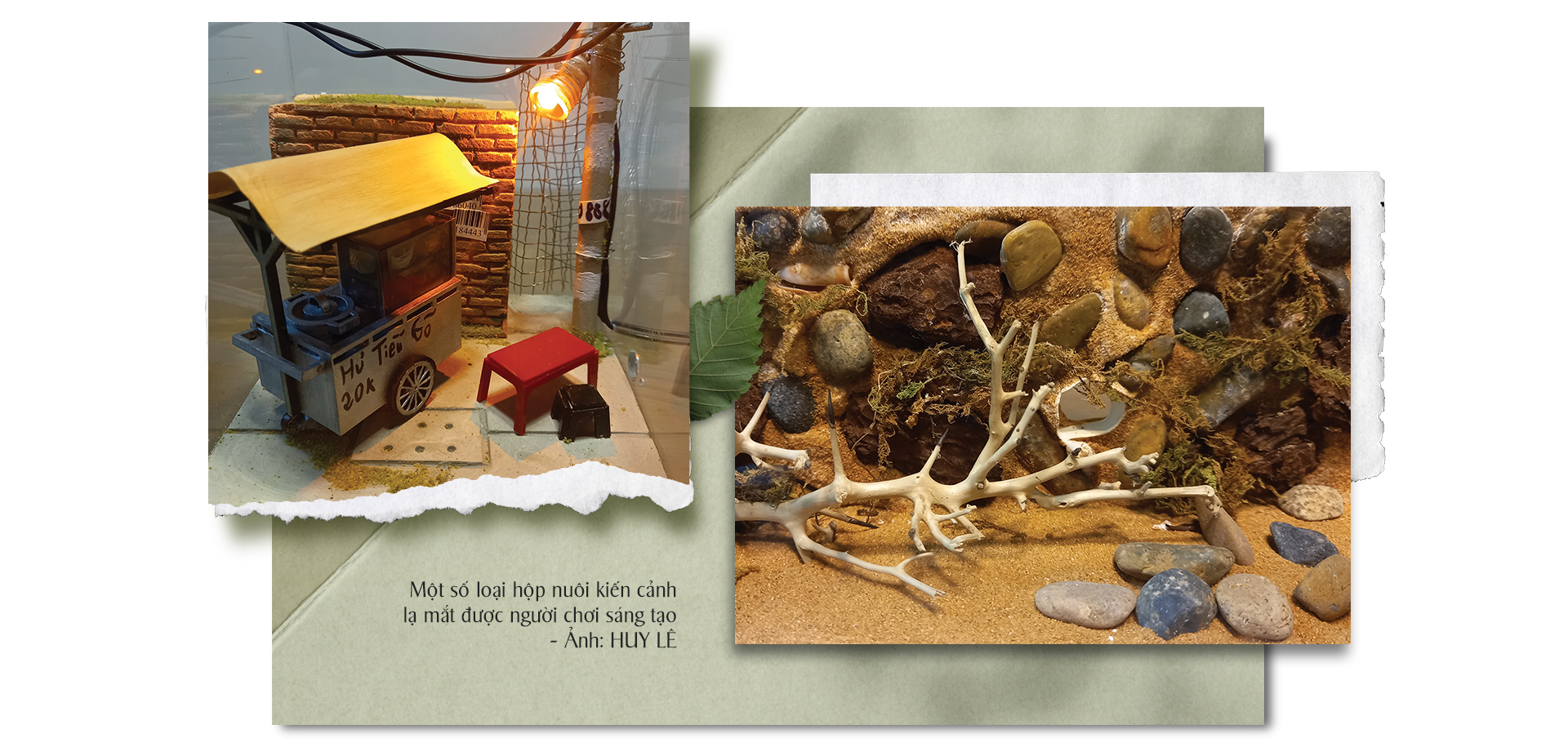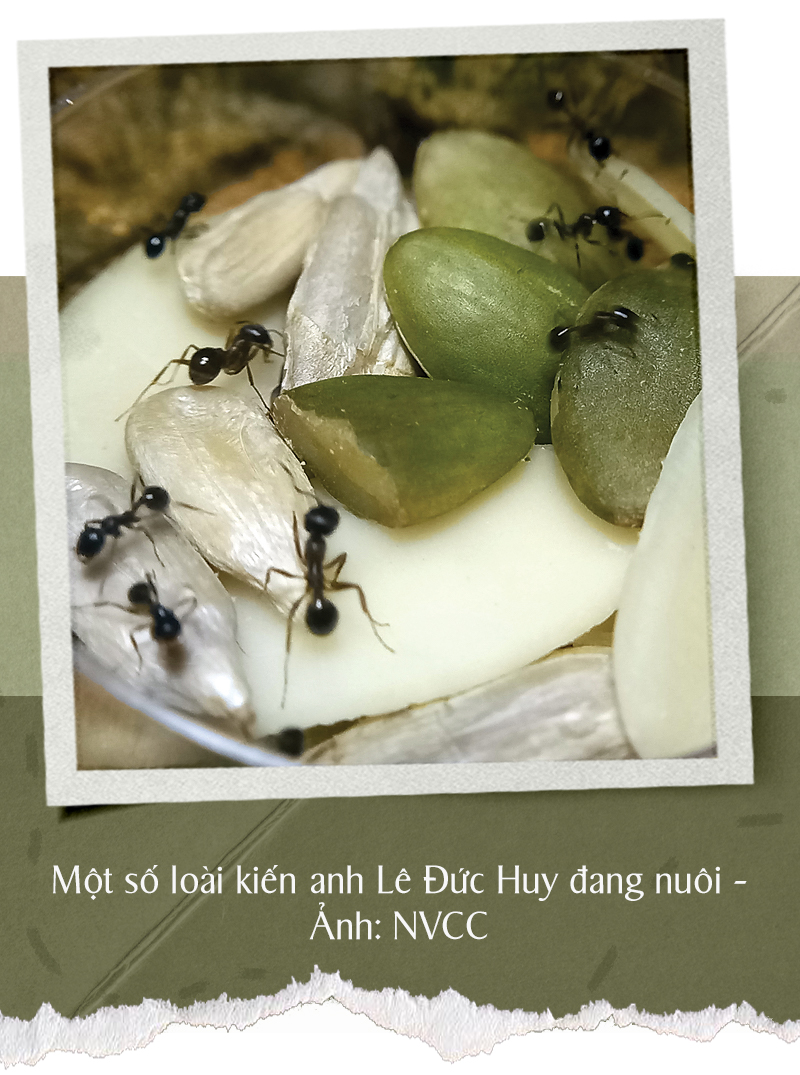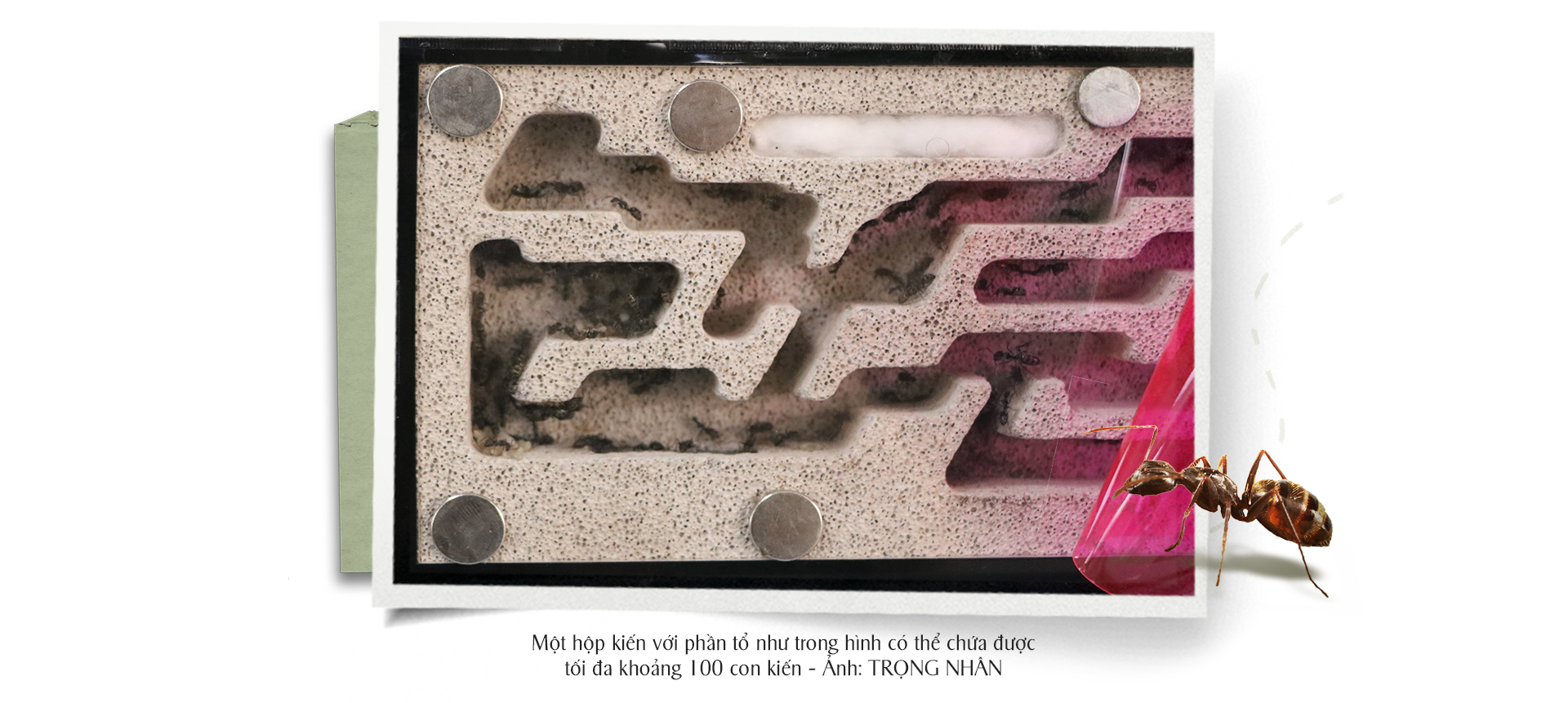One of Vietnam’s newest trends is ant keeping – a not-so-traditional hobby that involves caring for the ants, occasionally auctioning off colonies, and using the pastime to build a deeper connection with the natural world.
Nguyen Tan Minh Nhut, a 30-year-old resident of Binh Tan District, Ho Chi Minh City is busy putting the final touches on 30 formicaria – the formal name for man-made ant tanks – he plans to deliver to customers at the end of the week.
Each of Nhut’s ant farms boasts two compartments: a nest and an outworld.
The nest, made from cement or light brick, is typically placed at the bottom of the formicarium and is meant to simulate a natural ant colony.
It features a manmade system of tunnels that allows the ants to exist in nearly the same way they do in their natural habitats. Within these tunnels are a living area, food reserve, and nesting place.
Nests in formicaria are not always manmade. Ant keepers who prefer ant-led tunneling use sand and soil and let the ants tunnel as they please.
Atop the nest is the outworld, where ants can work and play.
 |
| Ant keepers sometimes make highly creative designs for their ant farms. Photo: Huy Le / Tuoi Tre |
To build an outworld, Nhut works closely with customers in order to meet their exact requirements. While some customers prefer stones and twigs so that the outworld resembles a rainforest, others prefer a more desert-like appearance.
There are even ant keepers who prefer to keep their formicaria simple and simply fill their tanks with little more than dry leaves.
Of course, different ant species require different environments.
Field ants, for example, prefer holes where they can play hide-and-seek, while ants which typically live on plants need spacious areas with lots of branches and twigs.
“An inappropriate outworld stresses the ants out. It reduces the efficiency of female workers and the fertility of the queen ant,” said Nhut.
“Sometimes the whole colony perishes.”
Formicaria feature a transparent cover which allows a clear view of their daily activities.
Many ant keepers liken watching their ants to viewing a living painting.
It takes meticulous work to design and assemble a formicarium. Even the tiniest scratches on the glass, or misplacement of mundane details, can create a nuisance for observers.
Formicaria must also be properly sealed to protect against any external factors and prevent outsider ants from encroaching on the colony.
“Keeping ants? Are you nuts?”
Raising ants is sustainable and basically cost-free.
Devoted keepers go to great lengths to build their colonies, often venturing to the suburbs of Ho Chi Minh City looking for queen ants after a torrential rain.
 |
| Le Duc Huy owns 10 species of ants, a few of them can be seen in this supplied photo. |
Some even brave the dangers of forest streams, hills, caves, and bushes to find rarer species.
“I often ride to Binh Duong, Binh Phuoc, or Dak Nong Provinces on ant-hunting trips. Even after driving between 45 and 250 kilometers, there are days I can’t find anything but snakes and centipedes,” said Nhut.
“I do occasionally find queen ants, but they don’t always lay eggs. I have to take them to a laboratory for inhabitation. Only 10 out of 100 queen ants can spawn a colony, and that process can take up to a year.”
Not everybody, however, appreciates the joy of ant keeping and Nhut occasionally experiences criticism for his love of ants.
“People get mad because ants damage their food, but ants are actually very clean,” said the experienced ant keeper.
“They typically take their trash away from the living area, so it’s important to make sure they have a few empty compartments to keep their garbage.”
Nguyen Hoang Ngan is a 25-year-old ant lover in Tay Ninh Province. His family simply cannot understand how he spends so much timing feeding, caressing, and even talking to his ants.
Yet, Ngan ignores the criticism, explaining that his hobby is extremely relaxing.
“Watching my ants relaxes me after hours of stress at work,” he said.
“They remind me to keep myself busy. It’s an indescribable joy to witness a hatching ant egg.”
25-year-old Le Duc Huy, another Ho Chi Minh City-based ant lover, uses his YouTube channel to share his knowledge about ants and provide ant-keeping tutorials for newbies.
Each type of ant is distinct in both looks and habits. Therefore, owning different species is seen as a sense of accomplishment for an ant keeper.
Huy currently has more than 10 species of ants in his collection, including the colorful Camponotus, and he claims to have learned a different lesson from each.
The diacamma ants, for example, are solitary hunters, but work together when a cricket is placed in their tank.
“I was staggered to see such unity in the natural world. The ants put aside their personal habits to work for a common cause,” he explained.
Ant auction
Considering the enormous amount of time it takes to go from a single queen ant to an entire colony, many ant keepers buy and sell ants, typically in packages of one queen and several female workers.
Social network groups of ant keepers generally ban the selling of the queen ant alone because of the potential for buyers to be scammed with immature or infertile queens. The most common rule seems to be that sellers can only offer queens that have produced at least 10 workers.
 |
| This design of an ant formicarium can hold up to 100 members. Photo: Trong Nhan / Tuoi Tre |
The prices for one ant tank ranges from VND300,000 (US$13) to VND800,000 ($35), depending on the ant species.
The most popular species are camponotus albosparsus and camponotus turcestanus due to their impressive appearances.
Buyers typically pay VND600,000 ($26) to VND1 million ($43.8) for a queen and 40-60 workers of these species.
The messor barbarus sells at VND600,000 for one queen and ten workers, while the tetra rufonigra is priced at VND500,000 ($21.9) for the same number of ants.
Purchasing a large colony is also a popular choice. Three queens and 100 workers of the rufipes species sell for VND650,000 ($28.4).
Meanwhile, 12 trap-jaw queens and 200 workers sell for VND1.2 million ($52.5).
According to ant keepers in Vietnam, these prices have gone up threefold over the last two years due to the increased popularity of the hobby.
Online auctions of ants on Facebook attract a great number of viewers. For the auction of a messier aciculatus tank with two queens and 50 males, the highest price was settled at VND600,000 after 30 bids, six times as high as the initial offering.
Ants require water, carbohydrates, and protein. Carbohydrates provide energy for the laborers and can come from honey juices or sugary liquids.
Protein caters for the gynes and larvae. This can come from crickets, caterpillars or worms.
Like us on Facebook or follow us on Twitter to get the latest news about Vietnam!


















































